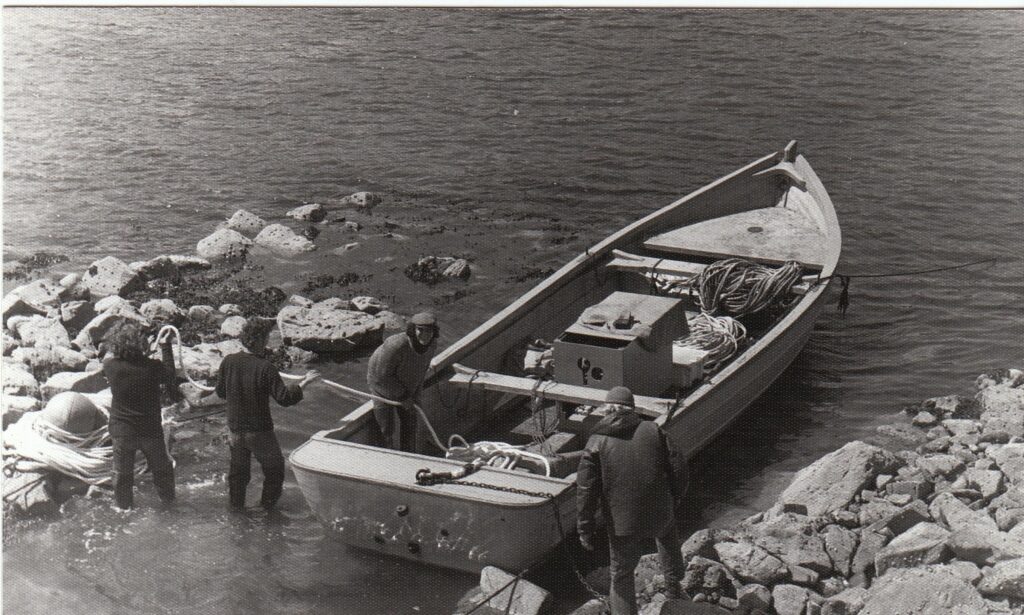Setting the net
The nets were “set” at the start of the season and lifted at the end. The season officially started sometime in February but the weather was then far too bad to be at sea and there would be very few fish to be caught at that time. At Fascadale the nets started to go into the water in late May. The season closed on the 26th August.
There was a lot to be prepared before a net was set.
The first thing to do was to put in the shore chains. These were short lengths of chain, up to two meters long that were shackled to the steel “pins” permanently drilled into the rock. The chains were there to keep the ropes running from the shore to the net from chaffing on the rock.

The pins were often quite difficult to find as they were encrusted with barnacles and amongst the seaweed.
Putting in the chains was a separate operation in itself. They would be loaded into the boat to be transported down the coast to each net position. This could only be done in calm weather as one member of the crew would have to scramble ashore from the boat which would be lying alongside the rocks. Once ashore the chain was shackled onto the pin and a temporary line and float left on the seaward end of it.
Once the chains were in the mooring could go in.
To set the mooring in its proper place, and to drop the anchor the correct distance from the shore the “setting line” was used to replace the leader and head. The setting line was the same length as the leader and head combined. The equipment to go into the sea was made up of from the land end pin, the land end chain, the land end rope, the setting line, the bridle with its buoys, the anchor hawser, the anchor chain, the anchor, the anchor buoy rope and the anchor buoy. Sound complicated? It was.
The land end pin, the land end chain and the land end rope would already be in place on the shore. The rest of the kit listed above had to be carefully tied or shackled together then very carefully loaded into the boat. This had to be done in “reverse order” with the seaward end of the mooring going on the boat first.

The anchor itself, which took four people to carry it was tied down on the after deck of the boat.
The last part to go into the boat was the landward end of the setting line. We would then set off, with a heavily loaded boat down the coast to the net position
When we arrived at the net position the land end rope was picked up from close to the shore and tied onto the setting line. The boat was then turned so that she was pointing out to sea. The rudder and tiller were lifted out so that all the rope and chain in the boat could be “shot” over the stern. To steer the boat the long “sweeps” or oars were mounted with a member of the crew on each.
When all was ready the boat slowly motored out to sea along the correct bearing to best set the net. These bearings, or angles were handed down verbally. You had to line up the top of “this hill” with “that rock”. If the net went in on the wrong line it was believed it would not fish so well. Each net went in on its own bearing and each had separate marks.
As the boat motored out the setting line followed by the bridle followed by the anchor hawser were payed out over the stern. At intervals along all this gear there were short ties, or stopper strops from the gear going into the water onto a strong point in the boat. When we came to one of these ties, the boat was accelerated to pull the gear in the water tight and the sweeps were used to get everything back on the right bearing. When everything was right the tie was cut and the boat would shoot forward as more gear went out over the stern.
This was quite a tense operation. One loop of rope round a crew member’s foot would have been a disaster. The power of the engine, the weight of the chain, the mass of the anchor would be lethal
After all the rope and hawser had gone out of the boat the heavy anchor chain also had a tie. When we were satisfied with the “line”, which usually meant lots of engine and pulling on the sweeps this tie was cut and the boat would leap forward with the last of the chain and the massive anchor being dragged off the stern. Scary.
The anchor buoy rope also had a tie which gave us a last chance to adjust the tension and position of the mooring but cutting this tie was not so dramatic: no massive anchor being dragged off.
The whole business of “setting’ the mooring is well described by Mike Barrett on pages 79 to 89 in his Fascadale book “The Leaper”
Once the mooring was in place the head and the leader could go into the sea.
